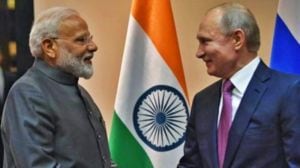A unipolar to tripolar world
In a recent research paper forecast, I had argued that the world will become bipolar in 25 years and tripolar by the middle of the 21st cent...

In a recent research paper forecast, I had argued that the world will become bipolar in 25 years and tripolar by the middle of the 21st century, and that this possibility would lead to greater technological cooperation between the US and India. In this context, the two recent US-India framework agreements (defence and nuclear) are just the beginning of a far-reaching transformation of the global order.
Translating potential into reality requires work, not only on India-US relations but, more importantly, on India-China ties over the next 12-18 months, to reap the benefits. First we should turn our attention back to the second pole — China — by implementing the agreements reached earlier this year between Prime Minister Manmohan Singh and Chinese premier, Wen Jibao. One was an agreement to enhance economic cooperation and double the volume of bilateral trade. The India-China study group (of which I was a member) had identified several constraints and barriers to trade in goods and services. India and China must work together to ensure that the route map outlined for addressing these issues is followed and the full potential of trade in goods and services is realised expeditiously.
The second was a framework agreement on defining the India-China border. Its importance can be gauged from the fact that since then prime minister Rajiv Gandhi’s pioneering visit to China, two decades of meetings on the border issue had failed even to define the line of control between the two countries. As India is quite used to the concept of an ‘LoC’, some Chinese objective or fear must have prevented this from happening. The framework agreement, therefore, reflects a change in China’s approach to India and this must be followed up to a successful conclusion. The key to an India-China border settlement and lasting peace is secure and defensible borders, not how much territory is exchanged. A fair, just and equitable settlement of the border that reduces the risks and enhances the security of both is in the long term interests of both countries.
The third is to carry forward the strategic dialogue. We could propose a bilateral agreement on non-proliferation of WMDs and nuclear/space technology to each other’s neighbours (eg, Pakistan, Bangladesh, Vietnam, Taiwan) in order to reduce suspicion and enhance mutual trust. To avoid any ambiguity, such an agreement should have an explicit, detailed list attached.
Our communist parties, the CPI and the CPM, can play a vital role in this process by convincing their fraternal party, the Communist Party of China, of the fundamental need for better India-China relations. The successful completion of these three steps would set the stage for a comprehensive cooperation agreement (FTA) covering goods, services, FDI and skilled personnel between the two countries. An India-China joint study group for the same could be set up by the end of 2006-7. This could lay the foundation for the formation of an (East) Asian Economic Community.
There is also a lot of work to be done on the Indo-US front. Indian businesses, including American MNCs in India, must work with the NRI/PIO community in the US to persuade the US Congress to change its laws and rules to provide India full access to civilian nuclear and all ‘dual use’ technology. At home, transparent rules and regulation for private investment (including FDI) in nuclear power must be put in place. A commercial Nuclear Power Corporation could be set up with 49.9 per cent government equity and 50.1 per cent private equity (investors, Indian companies and FDI). Some government re-insurance (for major catastrophe) as well as risk cover for loans and/or central purchase of nuclear power may be necessary initially (for the first few private nuclear power plants). The great advantage of such plants is that they can be subject to international rules and safeguards without affecting our existing nuclear establishment in anyway. Logically we can be “no worse off” than before, if we keep our current facilities as non-commercial ones for the time being. Subsequently we can declare one or more (Tarapur, RAPP) as commercial ones, if — and only if — it makes us “better off”. The choice is ours (nuclear experts), not that of the US or any other country.
We must also activate our diplomatic machinery to free up the flow of civilian nuclear technology from Japan, Russia, UK, France, Germany and other EU members. If this can be done by the time the US Congress approves the promised changes, India will reap the maximum benefit of competition among them to supply materials, equipment and power plants to India. We could similarly promote greater competition in defence technology transfers and co-production by signing appropriate agreements with Japan and others, where they are needed, to lubricate flows of defence technology or equipment. Though media reports suggest that F16/F18 deals are imminent, considerable staff work has to be done to give substance to the Indo-US defence agreement, so that the benefits begin to flow to both countries. We should also expand the discussion from air to naval equipment and components, without which a ‘minimum nuclear deterrent’ and ‘no first use’ nuclear policy is not credible to any recognised nuclear power.
If these and related issues are pursued with seriousness and determination, the Indo-US strategic partnership will help accelerate the transformation of the world from a uni-polar one into a stable tri-polar one, with the US, China and India as the three poles.
The writer is director & CE, ICRIER. Views expressed here are personal
- 01
- 02
- 03
- 04
- 05































